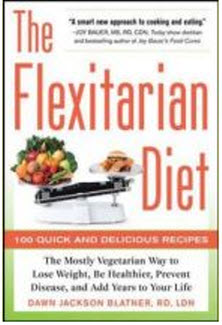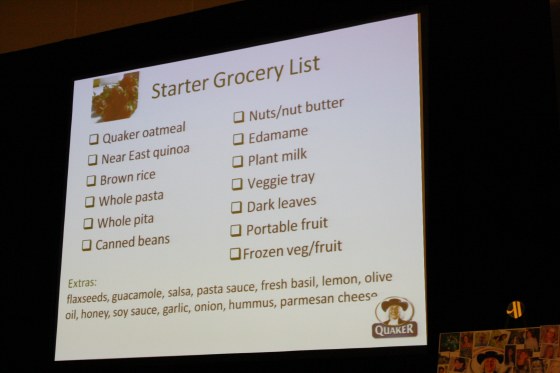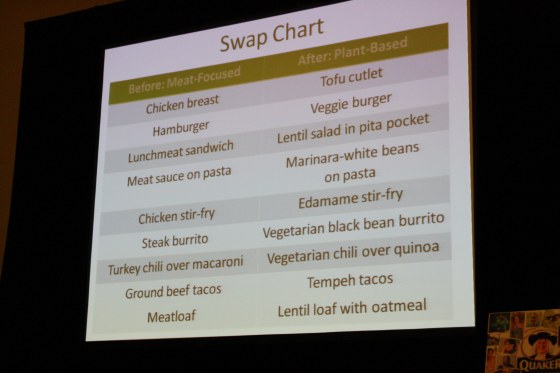On Saturday morning at the Healthy Living Summit, I had the pleasure to hear Dawn Jackson Blatner, RD speak as the key note speaker. I’ve been to quite a few conferences during my professional career and I’ve heard everything from skilled speakers to really boring speakers, so I feel like I have enough experience to make this statement. Ms. Blatner was one of the best keynote speakers I’ve ever heard speak. A lot of my fellow attendees have done wonderful recaps of the topics she addressed, but I feel like I have to also comment on her as a speaker.
-She knew her audience.
-Her enthusiasm was contagious.
-She was funny.
-She was charming.
-She came off as incredibly intelligent about everything she said and every question she answered.
-She was flexible.
…which especially appealed to me as someone who doesn’t do well with rigid rules.
Recently, Blatner wrote the book The Flexitarian Diet, which is self-described as “the mostly vegetarian way to lose weight, be healthier, prevent disease, and add years to your life.
Did you catch that?
“Mostly vegetarian” — in other words, anyone can become healthier by focusing more on a plant-based diet. The plan is flexible in that it meets each of us on our individual level.
Like I said, Blatner knew her audience, so she didn’t give a 30 minute speech on why a plant based diet is best. She knew that we already knew that. Instead she gave a brief summary on a vegetarian/plant based diet’s benefits. You know…lower risk of obesity and all kinds of horrible diseases, lower cholesterol, and better overall health.
So how is a flexitarian diet different than an omnivore’s diet?
The difference is in the intention.
An omnivore gets up every morning with the intention to eat some of everything, including both animal protein and plants.
A flexitarian gets up every morning with the intention to eat more like a vegetarian.
She gave the example of a client who is eating a steak burrito. She might suggest that he/she use half as much meat and sub in beans. Maybe this person will learn to like beans so much, they can completely remove the meat from the equation. Perhaps this swap happens only occasionally or maybe it turns into a lifestyle change. Regardless, this person is practicing the principals of flexitarianism by being more like a vegetarian.
Blatner also provided some real-life suggestions to put flexitarianism in action:
Ten quick ways to “flex” today.
A flexitarian’s starter grocery list.
A helpful swap chart to show easy changes you can make by swapping an animal protein for a vegetarian protein.
Now this is all fine and dandy, but what if you don’t like beans or some other vegetarian protein on this chart? Or worse yet, what if you don’t like vegetables? Blatner explained four different strategies to help ease you into flexitarianism and help your taste buds adapt to new foods.
1) The Coffee Principal
Vegetables can be bitter. By adding fat and sweet to a dish, like you would add cream and sugar to bitter coffee, you can make vegetables more tasty.
My sweet suggestions: barbecue sauce, organic ketchup, honey, brown sugar, Sriracha (sweet + spicy!)
My fat suggestions: cream sauce, cheese, yogurt, sour cream, avocado, nut butter
Suggested flexitarian recipes: Caramelized Maple Brussel Sprouts or Nutty Spicy Tofu
2) The Brighten Strategy
Brightening foods to make them more tasty is easy by adding salt or acidity like vinegar or citrus juice.
Suggested flexitarian recipes: I like adding balsamic to all kinds of veggie-centric dishes like my Sweet Potato and Chicken Sausage Hash and squeezing lime or lemon juice over salads like my Watermelon, Pistachio, and Spinach Salad.
3) Pairing a Like with a Dislike Strategy
You can learn to like things you typically dislike by pairing them with something you really like.
Suggested flexitarian recipes: I learned to like beets by roasting them (all veggies taste better roasted because it brings out a natural sweetness) and pairing them with things I really like in my Roasted Beet and Walnut Couscous. The whole green smoothie movement is basically built upon this principal as well. Here are some to get you started.
Now here’s my favorite!
4) The Umami Principal
Umami is a Japanese word that means “savory”, but after hearing it described in greater detail, I think a better way to describe it as “meaty in taste”. It’s what makes meat taste like meat, not meaty in the sense it is typically used to relate to texture.
Many foods possess the umami flavor outside of animal protein. Some of these are: tomatoes, green tea, cheese, carrots, mushrooms. Mushrooms especially have a high amount of umami. Blatner says that when you’re craving meat, what you’re actually craving is umami, so the craving is easily satisfied by eating a non-meat umami-rich food.
Suggested flexitarian recipes: Spicy Red Pepper and Tomato Bisque or Grilled Portobella and Red Pepper “Burgers”.
So what did I take away from all this?
– It confirmed my belief that a plant-based diet is best, but that you don’t have to be 100% vegetarian to reap the benefits.
– It helped me recommit to more meatless meals. Lately, I’ve been incorporating meat more and more. This hasn’t always been at the price of vegetables on my plate, but sometimes it has. Plus, I love vegetarian cooking. It really taps into my creativity and allows me to broaden my connection with all kinds of eaters.
– It confirmed a belief that I continue to hang my hat on — there’s not a one-size fits all approach for everyone. Most likely, we can all do a bit better at incorporating more vegetables in our diet, including vegetarians. Just because you eat little to no meat, doesn’t mean you’re getting enough produce in your diet. No matter where you stand on the vegetarian to carnivore spectrum, the principals of flexitarianism can be incorporated into your eating to improve the nutrition of your diet.
– It helped inspire some umami in my dinner last night, which you will see in my next post, called Meatless Meatballs or When Brad Learned to Like Tempeh. Stay tuned…
Blatner also generously provided her book, The Flexitarian Diet to each and every participant of the Healthy Living Summit. I can’t wait to read it and offer any additional insight I find between it’s pages.
I already considered myself a flexitarian, before attending HLS, but what about you?
What do you think of flexitarianism?
Do you consider yourself a flexitarian or would be willing to try incorporating its principals in your diet?







I think this sounds great! I wish I could have attended this conference to hear her speak, but I appreciate your re-cap! I am really interested in this flexitarian diet, as I have been trying to lower my consumption of meat. I feel like I need to do some more research, too, so that I can make sure that I am getting enough protein.
You should pick up her book. Perhaps they have it at the library if you don’t want to actually purchase it. There area a lot of great resources out there including some on the internet.
I really want to work towards being more Vegetarian and this makes it sound so simple. I have been reading a lot about this since I follow a lot of blogs 😉 Now I am fully convinced! Thanks for this post.
Great post highlighting the session with Dawn! I think it was the best thing I heard all day at Healthy Living Summit. It really summed up the way I usually eat and was happy to finally have a way to define it!
Thanks Brittney! She was such a great speaker and I really liked how she presented her ideas.
I think I’m a flexitarian. I try to have 4 oz of meat on the days I work out (usually 5 days). The other days, I make that protein up in beans. I get my other protein from eggs, nuts and seeds, etc. I have found for me personally, that I have to have meat for energy and calories. I don’t use any kind of protein powder or anything else to get calories, so I need the meat if I’m going to keep up the workouts I love. I just choose the best source possible. 🙂 Great post!
Sounds like you’ve found what works best for you! 🙂
I’m a total flexitarian and became that way on accident. I started buying more dry beans, lentils, and grains in a way to save money but didn’t realize I was eating less meat when making dishes with quinoa and lentils. It’s not bad, but people get scared when they hear you talk about no meat.
Another great benefit to flexitarianism that isn’t health related — it saves money! Thanks for pointing that out.
Any way people can eat more of a plant based diet makes me happy; sounds like this was a great presentation. Being a vegetarian is not for everyone but more vegetables sure are! 🙂
I agree!
I love, love your blog. So informative and creative. You truly are inspiring 🙂
Danielle
Thanks so much Danielle! 🙂
Pingback: Meatless meatballs | Foodie Fresh
I consider myself a pescatarian, but I definitely transitioned to this style of eating through a flexitarian diet. I love the idea of a flexitarian. I think it’s a great way for omnivores to start transitioning to a plant based diet. This post was very informative. Thanks for sharing!
I read the whole book on the plane, and while I don’t ever see myself waking up with the intention to be vegetarian,I did like a lot of the principles in the book. As someone who struggles to get veggies, i am going to try to do more with the “coffee principle” and use some other of her tips in my cooking! She was very good at public speaking!
Wow! You are a speed reader. I can’t wait to read it myself. But first, I have to get cracking on my book club book. Good luck trying to incorporate more veggies! I really think everything tastes better roasted.
Pingback: Follow-up: A Change of Heart (Giveaway Winners) | The Grass Skirt
Love this post, Kelly. I’ve been eating a lot more meat than normal since I’ve been pregnant, but I’m eager to see if I go back to my normal eating habits once baby is born. I’d never label myself a vegetarian, but last year I was only eating meat once a month or so. I love Dawn’s principles!
Wow! I didn’t know you ate that little meat. Just out of curiosity, do you cook meat for Jeff and just don’t eat it or is he good with eating little meat also?
Love your review and summary! I’m lucky that Dawn Jackson-Blatner lives in Chicago – I’ve been to two of her cooking classes and her class/book release session. I love the recipes in the Flexitarian Diet – I’ve even fed one of the recipes (as leftovers) to a group of guys at work and they never knew that it was tofu and not chicken. It’s a great way to make steps towards meatless meals and ease my family into not having chicken or beef at every. single. dinner.
Lucky! I’d love to take one of her cooking classes. She seems so incredibly sweet and intelligent – someone I would love to get to know and her ideas are pretty great too. 🙂
Pingback: HLS Session – Action Mantras | Foodie Fresh